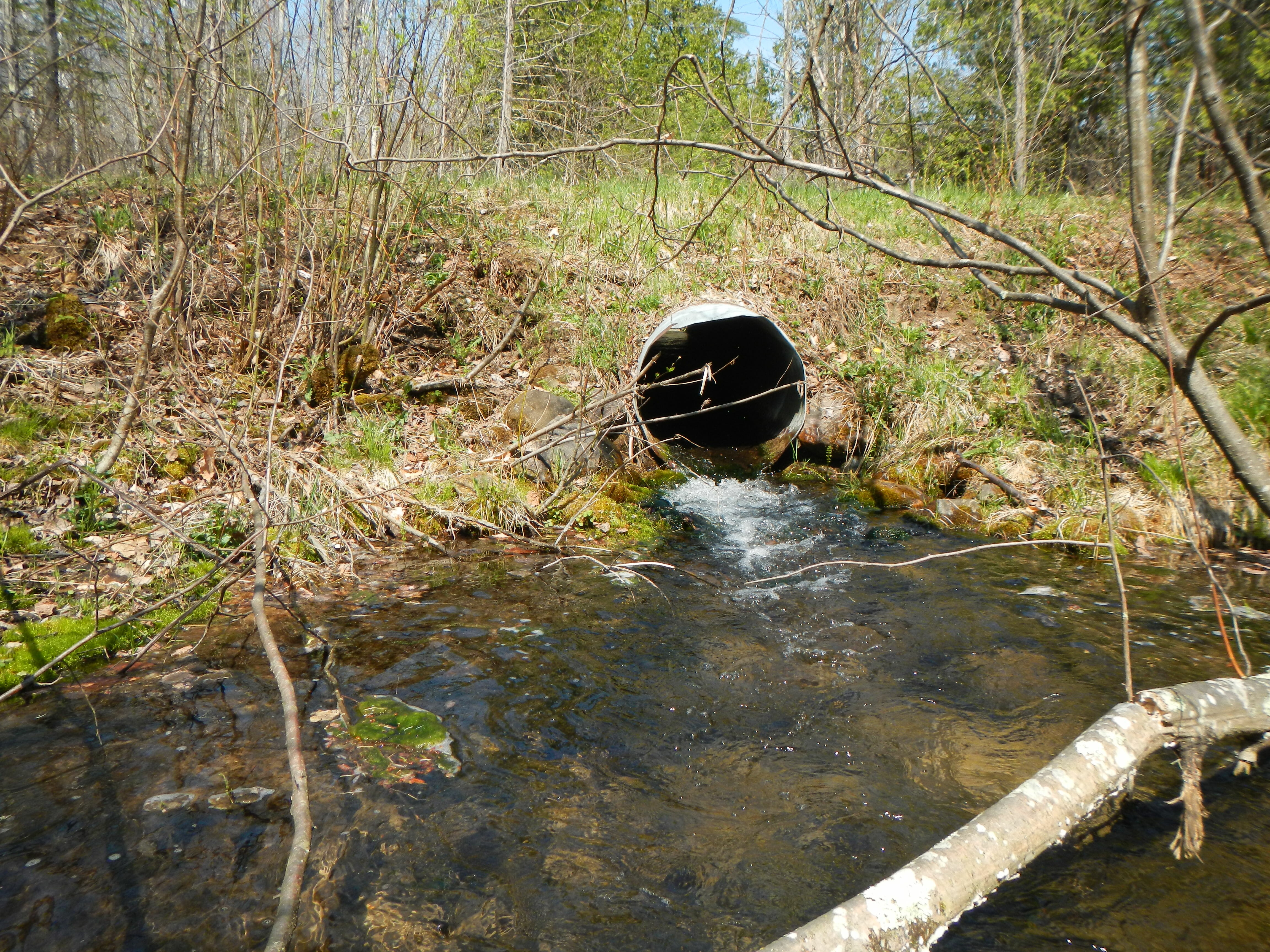By Laura MacFarland
A majority of Wisconsin’s 115 fish species, including trout, need to move throughout a watershed seasonally or at varying stages in their lifecycle to feed, find cooler water, avoid predators, and reach spawning habitat. Rivers, long and linear in nature, are vulnerable to habitat fragmentation thanks in part to our immense network of roads.
All too common, where black lines and blue lines meet on a map, aquatic habitat is severed or fragmented preventing fish and other aquatic organisms to move freely. Trout Unlimited staff and volunteers are working to restore connectivity within our trout streams through the replacement of inadequate or damaged culverts. While improving the fishing, our efforts will also prevent road failures, a catastrophic scenario which poses great risk to human life and the health of our rivers.
A Wisconsin angler landing a 10 inch brook trout in a familiar reach of stream may assume that the trout has been living in the neighborhood for it entire life, unaware of the trout’s reliance on the connectivity of the river and its tributaries. It is possible that the trout, now in hand, has just completed its annual 20 mile migration. You may recall research conducted in the early 1990s in Wisconsin documenting the seasonal movement of trout. One study found that when water temperatures reach approximately 60F in the Oconto River in May, trout began migrating up to 30 miles upstream to the South Branch for the summer. The bigger, deeper, warmer water of the Oconto River provided better winter habitat and greater forage allowing the fish to grow larger.
While the South Branch provided refuge from the rising temperatures in the summer, as well as better spawning and rearing habitat. This documented inland migration pattern of trout results in fish that live longer, grow larger, and are more resilient to a changing climate and disease.
Dams are an obvious culprit. However according to the University of Wisconsin- Madison Center for Limnology, while there are more than 7,000 dams on the rivers, creeks and streams flowing into the Great Lakes, there are over 265,000 road stream crossing – most of them culverts. The majority of culverts currently in place were designed with the primary objective of moving water under a road. Little consideration was given to the river’s natural hydrology, sediment transport, fish and wildlife, or movement of woody debris.
So, it is not too surprising that researchers suspect that 64 percent of culverts in the Great Lakes region may block fish movement. While the removal of a large dam makes great headlines, nationwide TU has found that by replacing a substandard culvert with a fish friendly crossing is more cost effective and often less controversial, enabling us to have a greater impact, faster and cheaper.
There are several ways in which a culvert can present a physical barrier to fish trying to swim upstream. The most obvious type of barrier is the “jump barrier”. These are culverts that are set at too high of an elevation resulting in a perched structure that would require a fish to jump up into the pipe. The second type of barrier is a “velocity barrier.” Culverts that are too narrow or are installed at an improper slope result in high water velocities at the outlet. While we tend to think of trout as relatively strong swimmers, once water velocities in a pipe approach or exceed 3 feet per second, brook trout have a difficult time swimming up through it. The longer the pipe the tougher it becomes; we refer to these longer pipes as “exhaustion barriers.”
Finally, a pipe that is too large poses another problem at lower flows, shallow water. These “depth barriers” detour fish that are accustomed to avoiding shallow water due to swimming inefficiencies or fear of predators from above.
In addition to presenting physical barriers to fish movement, improperly designed, installed or maintained road stream crossings can degrade or destroy habitat upstream and downstream of the structures. Here are three examples. When a culvert inlet is placed at too high of an elevation ponding can occur resulting in the deposition of silt, organics and other fine materials upstream. This can bury spawning gravels and fill pools that previously had provided cover for fish.
When a culvert is too short it results in the slope of the embankment being too steep. This can cause sloughing of road gravel and other material into the stream having a similar effect and potentially compromising the structure. The third and most extreme example of how a bad road crossing can impact habitat, is when a culvert fails causing a road washout. Unfortunately, as many of us in the Driftless Area or the Chequamegon National Forest witnessed firsthand this year, the failure of a culvert or bridge due to inadequate engineering or disrepair causes a great deal of destruction to our streams, not to mention putting a problematic gap in our transportation infrastructure.
In 2016 TU National began a concerted effort in Northern Wisconsin to reconnect over 30 miles of coldwater habitat. Partnering with the United States Forest Service, the Wisconsin Department of Natural Resources with additional support from the National Fish and Wildlife Foundation and Trout and Salmon Foundation, TU is working to replace or remove a total of 10 culverts in 2017. Over 33 miles of coldwater tributaries will be reconnected to the Peshtigo River.
Greg Orum, Trout Unlimited’s stream restoration specialist, is currently working with USFS engineers and hydrologists to design the new road stream crossings. Their approach, based upon the United States Forest Service Stream Simulation Methodology, entails matching the width, elevation and slope of the culvert with that of the natural channel to minimize or eliminate the impact of the road on the stream’s geomorphology. This allows aquatic organisms, silt and the majority of woody debris to pass through the culvert unimpeded. Greg will also apply hydrologic modeling to ensure that the culvert is large enough to stand up to large flood events.
While Trout Unlimited’s mission is to restore coldwater habitat, we and our partners believe that these projects benefit our local communities, as well. Like much of our transportation infrastructure, many culverts are reaching or have exceeded their life expectancy and are in need of replacement. In the event of a failure or imminent failure, municipalities and towns often replace the bad culvert with one of similar dimensions – a missed opportunity to improve the resiliency of both the road infrastructure and the river.
Trout Unlimited’s financial contributions and expertise is helping to take the burden off of towns and counties, prevent future catastrophic, life-threatening failures and ensure coldwater connectivity. It’s a win-win.
Laura MacFarland is TU’s Great Lakes stream restoration manager. She lives and works in Wisconsin.



